Procedures
Additional Positions
This page describes procedures for a few additional positions on Northern Light.
If you're not familiar with some of the terms or concepts on this page, look them up in the Glossary and review the Sailing Basics page.
Boat Spotters
The primary responsibility of the boat spotters is to monitor the boats in our class during our race.
Knowing where the boats in our class are and what they're doing doing is crucial – it informs our decisions about where to sail and what tactics to use. For example:
- We may decide to “cover” a boat that's behind us in order to minimize their opportunity to overtake us.
- We may decide not to engage in a tacking duel with a boat that's ahead of us in order to prevent a boat that's behind us from catching up.
- We may decide to enforce our rights to go around a mark (buoy) ahead of another boat.
As a boat spotter, you will be given a specific boat to monitor. At any point in time, you should know:
- exactly where your assigned boat is (you should be able to point to it any time somebody asks you where it is)
- whether your assigned boat is on starboard tack or port tack
- how much time your assigned boat was ahead of us or behind us at the last mark (buoy)
- whether your assigned boat is catching up to us or falling behind
Items (1) and (2) are harder to do than it sounds: If you take your eyes off your assigned boat to do a job on our boat, it can take you a while to find your boat again when you finish your job. Make it a practice to spot your assigned boat every minute or so – think of it like checking your rear-view mirror when you drive. Items (3) and (4) are discussed below.
Friday Night Races are handicapped: Boats that are fast owe a certain amount of time to boats that are slow. The exact amount of time owed depends on the speed difference between the boats and the length of the race course. In order to determine whether we beat your assigned boat, we need to know how far ahead or behind our boat finishes relative to your boat. Thus, one of your jobs is to measure the elapsed time between when our boat crosses the finish line and when your boat crosses the finish line.
It's also helpful for us to know the time difference between our boat and your assigned boat along the course. You can only measure that time difference reliably when we go around marks (it's easy to tell when a boat turns around a buoy). As between our boat and your boat, one boat will be the lead boat, and one boat will be the trailing boat. At every mark, you should start your stopwatch when the lead boat turns around the mark, and note the time difference when the trailing boat turns around the mark.
In between marks, it's helpful for us to know whether your assigned boat is catching up to us or falling behind. It's hard to tell the relative position of boats on the water, but there are a couple of ways you can estimate whether your assigned boat is catching up to us or falling behind:
- Use a small ruler to measure the height of the mast of your assigned boat:
- Hold your arm out straight and visually line up your ruler with the mast of your assigned boat. Note the height of the mast. Take another reading a minute or so later. Assuming your boat is behind us, if its mast is getting bigger, that means it's catching up to us.
- Use a bearing compass to measure the bearing to your assigned boat:
- Look through the compass and line up the compass' lubber line with the mast of your assigned boat. Note the bearing to the boat (e.g., 270°). Take another bearing a minute or so later. Point your compass back to the first bearing that you took to determine whether your assigned boat is catching up to us or falling behind.
Before we sail:
At the dock:
- Ask Rod what boat you should spot for our race.
- If you don't remember the sail number for your assigned boat, look it up on the fleet cheat sheet (a small laminated card prepared for the crew).
- Borrow a bearing compass from Rod or Carl, and practice using it. (Ask another crew member to show you how to use it if you don't know how.)
Before the start of the race:
- As we sail up to the start line, look for your assigned boat. Not all boats make every race – it's important for us to know if your assigned boat is sailing on the day of the race. Let Rod and the crew know as soon as you spot your boat.
- Assuming your assigned boat is sailing:
- Tell Rod whether your boat is sailing with us (in the same direction as us) or away from us. This is likely to change several times as boats jockey for position before the start of the race. Tell Rod every time you see your assigned boat change direction.
- Tell Rod if you see your assigned boat doing anything to its sails – e.g., reefing (partially lowering) its mainsail, or changing its jib.
During the race:
Advanced procedures for boat spotters:
- If we're on a collision course with any boat (not just your assigned boat), tell the driver. If you know which boat has the right of way, call it out (e.g., “we're on starboard tack; they're on port tack, so we have right of way.”)
- If we get into an incident with any boat – e.g., a dispute at the start line or near a mark, or a near-collision anywhere on the course – watch the other boat closely to see if they put up a red protest flag on their backstay, or if they hail “Protest!” Let the crew know immediately if the other boat flies a protest flag or hails “protest.”
- As a spotter, you can get involved in discussing and determining tactics. Start by getting familiar with the Racing Rules of Sailing:
- Read a summary of the rules, focusing especially on the port-starboard rule and the windward-leeward rule. Look at the illustrations below the “executive summary,” and ask Rod or other crew members if you need help understanding the rules.
- If there's an overlap between our boat and your assigned boat, keep track of how that overlap was established: Did the leeward boat cross the overlap line with its bow within 2 boat lengths of the windward boat?
- How the overlap is established determines how far up the leeward boat can head.
- At every mark, determine whether there is an overlap between our boat and your assigned boat when the lead boat crosses an imaginary circle that is 3 boat lengths out from the mark.
- Whether there's an overlap when the boats cross into the 3-boat-length zone determines which boat has the right to go around the mark first.
Heel Director
The primary responsibility of the heel director is to direct the crew where to sit or stand so that the boat maintains an optimal heel angle.
Northern Light sails fastest when it heels (tilts) 10° to 15°. As heel director, you must get the crew to shift their positions (i.e., their weight) in order to maintain that heel angle. Specifically:
- When we sail to weather (upwind), the boat usually heels to much. You must get the entire crew to sit up on the windward rail (the high rail) in order to get the boat to heel less.
- When we sail to lee (downwind), the boat usually does not heel enough. You must get the crew to sit or stand on the leeward (downwind) side of the boat in order to get the boat to heel more.
Maintaining an optimal heel angle is crucial to boat speed – it can easily make a difference of 20% or more in speed. Don't be shy about asking the crew to move – it can make the difference between winning and losing a race.
Before the race:
Procedure for the heel director:
Tips for the heel director:
- Give commands to the crew like the ones below. Speak loudly when you give commands.
- “Weight to port!”
- “Weight to starboard!”
- “Weight out!”
- “Weight in!”
- If the crew is slow to follow your commands, call people out by name, e.g., “Andy sit on the rail!” or “Andy get your head under the lifeline!”
Pulpit at the Start
The primary responsibility of the crew member in the pulpit at the start is to tell Rod how close we are to the start line.
We want to cross the start line as close to the start signal as possible, but not before. (If we cross the start line before the start signal, we need to go back behind the start line and cross the line again.) By telling Rod how close we are to the start line, you help Rod adjust the boat's speed and distance to the line so that we cross the line with maximum speed and as close to the start signal as possible.
The start line is an imaginary line that runs between the orange flag on the race committee boat and the buoy marked “SC.” The buoy is anchored, but the race committee boat sets up in a different location for every race, which means the start line is different for ever race.
| Race Committee Boat (RC) |
Buoy SC |
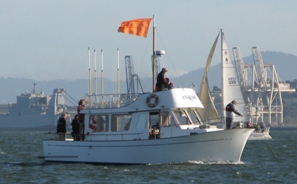 |
 |
In order to gauge how close we are to the start line, you need to sight the start line before the race. “Sighting the start line” means visually lining up the ends of the start line with a fixed object on land. You sight the start line in both directions, as shown in the diagrams below (diagrams are not to scale):
| Sighting in One Direction |
Sighting in the Other Direction |
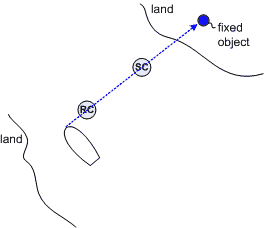 |
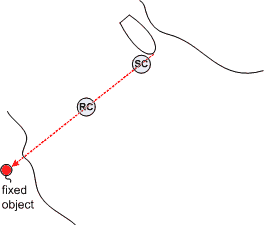 |
Sighting the start line in both directions gives you the option to look either to port or starboard at the start of the race. This is helpful in case a boat blocks your view in one direction. You know we are at the start line when the fixed objects you identified earlier line up with the race committee boat or the buoy SC:
| Start of Race |
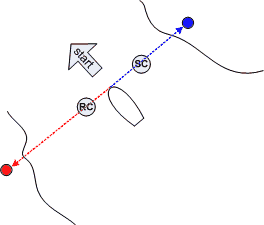 |
Procedure for sighting the start line:
- Stand in the bow pulpit and hold on to the forestay with one hand.
- As we approach one side of the start line, look for when the orange flag on the race committee boat lines up with the buoy SC.
- When the orange flag and the buoy are lined up, identify a fixed object on land that is also lined up with the flag and the buoy. Remember this fixed object.
- Repeat the same procedure on the other side of the start line: Identify a fixed object on land that lines up with the orange flag and the buoy. Remember this fixed object as well.
Procedure for approaching the start line at the start of the race:
- Stand in the bow pulpit and hold on to the forestay with one hand.
- Point your free arm straight down (toward the water). As we get closer to the start line, raise your arm slowly toward the sky:
- When we are one boat length (35 feet) away from the start line, start raising your arm.
- When we are ½ boat length away from the line, your arm should be at 90° (parallel with the water).
- When we are exactly on the start line, your arm should be at 180° (pointing straight up).
- If we are over the line, wave your arm from side-to-side over your head.
- To gauge how close we are to the start line:
- Look to port or starboard (whichever side gives you a clear view of the race committee boat or the buoy SC).
- Look to see how close the race committee boat or the buoy is to the fixed object you identified earlier. When the race committee boat or the buoy lines up with the fixed object, we are on top of the start line. At this moment your arm should be at 180° (straight up).
- After the start of the race, go sit up on the windward rail with your weight out.
Start Timer
The primary responsibility of the start timer is to tell Rod how much time is left before the start signal for our class.
We want to cross the start line as close to the start signal as possible, but not before. (If we cross the start line before the start signal, we need to go back behind the start line and cross the line again.) By counting down the time before the start signal, you help Rod adjust the boat's speed and distance to the start line so that we cross the start line with maximum speed and as close to the start signal as possible.
To help Rod and the crew gauge how much time is left before our race, the start timer:
- counts down the time to the “first shape” (the first flag that the race committee puts up, usually at 6:30pm)
- counts down the time to the start signal for our class (in 2014, Northern Light is in
Class D, which is scheduled to start at 6:35pmClass E, which is scheduled to start at 6:40pm Class G, which is scheduled to start at 6:50pm)
Before the race:
- Get a stopwatch and a countdown timer. There are some fairly cheap watches that have both a stopwatch function and a countdown function. You might want to get a watch that is specifically designed for racing – see a review of race watches, which run the gamut from a relatively cheap Timex to an exorbitant “wrist-top computer” that will set you back several hundred dollars. If your watch doesn't have a countdown function and you don't want to buy a new watch, you can even make do with a kitchen timer.
- Look at a photo of the race committee boat so that you can spot the boat easily when we're on the water (see Figure 5 below).
- The race committee gives signals by raising flags. A signal is deemed to be officially given when a flag reaches the top of a flag pole on the race committee boat. For example, the first signal that the race committee gives is the 5‑minute warning signal for Class D. The race committee gives this signal by raising the “D” flag, along with the course number that the boats in Class D must use. The 5-minute countdown for Class D starts when the “D” flag hits the top of its flagpole – i.e., the start for Class D is precisely 5 minutes after the “D” flag hits the top of the flagpole. (Note that the warning signal for Class D is called the “first shape,” since it's the very first flag that the race committee puts up.)
Review the Start-of-Race Sequence to get familiar with the sequence of signals the race committee uses, and the timing of those signals.

Figure 5: Race Committee Boat “Anabel”
At the dock:
- Sync your watch with a clock that's synced to the atomic clock signal (e.g., Andy's GPS watch or John's iPad). This will help you count down the time to the first shape accurately: The race committee uses a watch that is synced to the atomic clock signal, and they almost always put up the first shape at precisely 6:30pm.
- Set your countdown timer for 5:00 minutes. (This assumes that we're in Class D, which starts 5 minutes after the first shape.)
- Set your countdown timer for 10:00 minutes. (This assumes that we're in Class E, which starts 10 minutes after the first shape.)
- Set your countdown timer for 20:00 minutes. (This assumes that we're in Class G, which starts 20 minutes after the first shape.)
After we leave the dock:
- We typically leave the dock around 5:30pm and practice a spinnaker set. Give Rod a warning when it's 6:00pm, and then again when it's 6:15pm.
- As we make our way to the start line, count down how much time is left until the first shape (6:30pm).
- When counting down the time, start by calling out the minutes, e.g., “2 minutes to the first shape.”
- When there's less than 1 minute left, call out the seconds, e.g.: “60 seconds to the first shape ... 50 seconds ... 40 seconds ... 30 seconds ... 20 seconds ... 10, 9, 8, 7, 6, 5, 4, 3, 2, 1, first shape!”
- When the race committee puts up the first shape, start your
5-minute
10-minute
20-minute
countdown timer.
- Count down the time to the start signal for our class.
- Call out how many minutes are left, and when there's less than 1 minute left, call out the seconds.
- Immediately after the start signal:
- Check to see that the race committee has put up the flag for the next class
(Class E)
(Class F)
(Class H).
This confirms that the start was for our class
(Class D)
(Class E)
(Class G).
- Check to see whether the race committee has put up either the individual recall flag or the general recall flag (see recall flags). If so, shout “RECALL.”
- If we're over the start line early and the race committee puts up an individual recall flag, keep looking at the recall flag and
call out when the race committee lowers the recall flag. That indicates that we have gotten back to the pre-start side of the line
and can start sailing to the weather mark again.
Tips for the start timer:
- Don't call out bare numbers. There are usually several people calling out data to Rod (course number, GPS readings, etc.), so tell Rod exactly what data you're providing, e.g.: “3 minutes until first shape” or “3 minutes to the start signal.”
- It can be hard for Rod to hear you all the way at the back of the boat. When calling out the time, turn to face Rod, and speak loudly.
- Most signals from the race committee include both a visual signal (e.g., raising a flag) and a sound signal (e.g., firing a gun). The signal that counts is the visual signal, i.e., when a flag hits the top of the flag pole on the race committee boat. Listen to sound signals but don't rely on them – depending on how far we are from the race committee boat, there will be a delay between when a flag hits the top of the flag pole and the corresponding sound signal. Once in a while the start gun will misfire and there won't be a sound signal at all. The official signal is always the visual signal, i.e., when the flag hits the top of the flag pole.
Afterguy Tailer
TODO -- get writeup from Kirk & Lynne; also add a summary to the overview page.

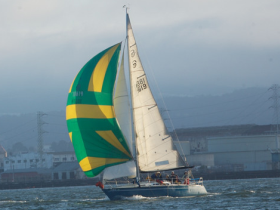 Home
Carpool
Contact Info
Debrief
Fleet Info
Links
Logistics
Marks & Courses
Photos & Videos
Procedures
Results
Rules
Sitemap
Home
Carpool
Contact Info
Debrief
Fleet Info
Links
Logistics
Marks & Courses
Photos & Videos
Procedures
Results
Rules
Sitemap



